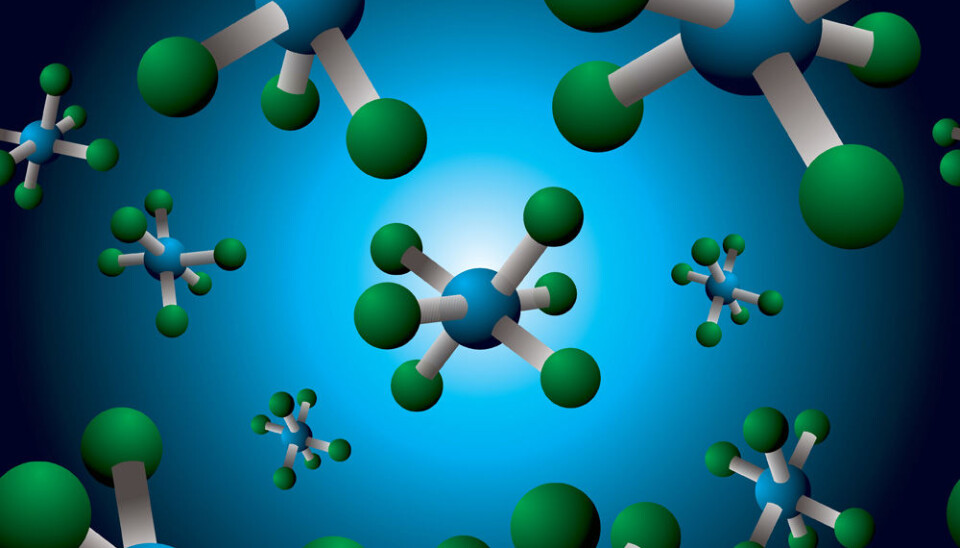
Danes crack atom bonding code
Atoms attach and detach according to a fixed pattern. A new theory explains how.
On-and-off relationships are not restricted to humans only. It happens to atoms too. Now Danish physicists have come up with a theory that describes how and when this happens.
They have developed a new theoretic model which describes what makes single atoms seek a partner and what later makes them break out of their relationships.
The model will help physicists predict a long list of atomic behaviours and will lead to a deeper understanding of the structure of matter.
Valuable knowledge
Many substances behave strangely when they are cooled down to extremely low temperatures. A copper wire, for instance, suddenly becomes highly conductive, enabling electric current to pass through it without any loss of energy to the surrounding environment.

It has long been known that these changes occur because the cold environment affects the atoms inside the substances. The cold environment can cause the atoms to seek new partners or join a new cluster of atoms, or break out of their current relationships and seek new ones or even opt for a life of solitude.
A team of researchers from Aarhus University has now found a way of describing these highly complex internal relations and fractures of atoms along a fixed pattern.
“Our findings can be of great value in the design of new materials,” says one of the researchers, postdoc Nikolaj Zinner. “It is essential for these designers to understand how the atoms and molecules inside the various materials are structured, how they attach to one another and when they choose not to bind at all.”
Cold atoms controlled by quantum mechanics
Physicians have a significant understanding of how large objects such as the sun and the earth function. But when it comes down to the molecular level, a whole new set of game rules apply.
Our findings can be of great value in the design of new materials. It is essential for these designers to understand how the atoms and molecules inside the various materials are structured, how they attach to one another and when they choose not to bind at all.
At this level, classical physics and logic fail to provide a satisfactory explanation. This is where the complexities of quantum mechanics kick in. Here there are no gradual transitions in energy; rather, the changes occur in much larger steps – the so-called quantum leaps. When two atoms attach, a certain amount of energy is required to break this bond. It is these complicated states of attachment that the new theory seeks to describe.
Bright young PhD student cracked the nut
Physicians have struggled to come up with a theoretic model of atomic bindings ever since the early days of quantum mechanics some 80 years ago.
And now, thanks in large part to Zinner's Ukranian Ph. D. student Artem Volosniev, the numbers are starting to add up.
“Our model can predict when atoms or molecules bind to one another in two or one-dimensional geometries,” says Zinner. “We now have a mathematical formula to explain the various properties at these stages. This is a very attractive model, both from a mathematical and a physical perspective.”
The new model can solve two general kinds of tasks:
1. It is sufficiently general to cover any conceivable questions about bound states – not only in atomic and molecular physics, but also particle and nuclear physics. It is, for instance, important to know how two atoms bind to each other in order to predict how three or four atoms can form even bigger units.
2. The model provides accurate conditions for when bound states can exist on one and two-dimensional objects.
2D was the main challenge
The new model will be particularly useful in gaining an understanding of how atoms behave on two-dimensional surfaces.
1D and 3D atomic behaviour is quite similar, but in 2D things are completely different, says Zinner.
“Lots of physical phenomena rely on 2D physics, for example electrical currents on metal surfaces. So that's why scientists have been desperate to find a way of describing atomic behaviour on 2D surfaces – and that's one of the things we are now able to contribute to now.”
The model provides an insight into areas such as what kind of bound quantum state the atoms are in, the distance between them, to which degree they can sense one another and how much energy it takes to break the bond between them.
Describes the physics in everything from solar cells to LCD screens
The new model can for instance help scientists understand how solar cells convert light to electricity at atomic levels. This knowledge could lead to significantly better solar cells in the future.
In a solar cell, the sunlight creates pairs of particles on the metal surface, consisting of an electron and an antielectron. The electricity produced by the solar cell relies exclusively on the quantum state/mode of these particle pairs. And it is exactly these states that the new model can describe.
Another area where the new theory can be successfully applied is in the construction of LCD (Liquid Crystal Display) screens. Screen manufacturers are currently planning to make the floating crystals much smaller than they are today. But the smaller they are, the more they will rely on quantum mechanics.
The new model can describe whether one, two, three or more crystals will attach to one another under certain conditions. This will enable manufacturers to gain significantly more control over the inner workings of their screens.
The new findings were published in Physical Review Letters and Journal of Physics B.
Read the article in Danish at videnskab.dk
Translated by: Dann Vinther






